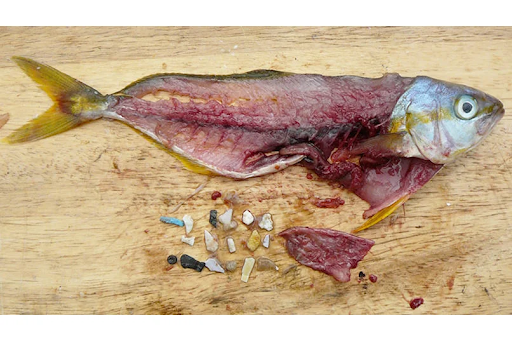CASEY HUBER
Special to The Leader
Plastic pollution is in every corner of our world.
In fact, the level of global pollution is so high that trash has been found in the deepest surface of the Earth, the Marianas Trench, as well as the highest peak of our world, Mount Everest, according to National Geographic.
If you are a person who cares about the environment, you might have heard of a newly discovered form of plastic pollution called “microplastics.”
The problem has two major heads: One head is the physical presence of the microplastics, and the other is the chemicals those microplastics leech into the environment around them.
Physically, microplastics are confused with food by small ocean creatures and thus microplastics jutt their way into the food chain.
Microplastics accumulate in the stomachs of the creatures that eat them, until bigger creatures eat those creatures until eventually we see pictures like the one below.

The increase in concentration of microplastics or any type of pollutant spreading upwards through the food chain is called bioaccumulation.
This phenomenon also applies to more well known pollutants such as mercury. Mercury is dumped from factories into the water supply and then is eaten by microbes. Small fish eat those microbes, passing along the mercury to that creature. Then, bigger fish eat the smaller fish, the mercury accumulates in larger and larger quantities, until eventually humans eat the fish. This is due to the storage of mercury in the fatty tissues, rather than the mercury being passed through the digestive tract of the fish.
The same is true for microplastics, only with the difference that microplastics are not stored in the flesh, but rather the stomach. In the case of microplastics, organisms will potentially eat more microplastics than food.
“If they are feeding on these plastics they may feel sated and not continue to eat food,” said SUNY Fredonia environmental professor Dr. Courtney Wigdahl-Perry.
Microplastics moving through the digestive system of the creature can cause physical laceration as well, potentially killing the creature. However, since humans do not eat the stomachs of the fish, we avoid the physical microplastics.
But, the pollutants do not stop there. Through chemical leaching, a process by which pollutants release chemicals into the surrounding environment as the physical component decays, the flesh of the fish absorbs toxic chemicals.
“They also have the potential to absorb other chemicals onto them as they are traveling through the environment and release them later. That piece is less well understood because the chemistry is so complex,” Wigdahl-Perry said.
Whether it is mercury or microplastics, chemical leaching places toxic chemicals into the food we eat.
But, again, the pollutants do not stop there. These examples have impacted the inside of creatures, but microplastics also release toxic chemicals into the water they inhabit.
Freshwater sources are a scarce and shrinking resource. According to a 2017 BBC report, “Of the world’s major aquifers (gravel and sand-filled underground reservoirs), 21 out of 37 are receding,” author Tim Smedley said.
“Already, the amount of drinkable freshwater we have is diminishing with our urban sprawl. It’s really important to preserve the sanctity of our water sources, and if that means keeping microplastics out, so be it,” SUNY Fredonia sophomore Earth studies major Justine Bloom said.
Bloom, alongside myself, has been conducting research on microplastics since the beginning of fall 2021. We have been working on papers, presentations and journalistic articles with the purpose of bringing the issue of microplastics to the attention of the public.
“The scientific field is aware of the issue, it’s really just bringing it to the public. There’s been a substantial amount of research done, but the consensus is that there is no ‘one size fits all’ Band-Aid that you can put over it,” Bloom said.
Wigdahl-Perry believes that the role of the individual is important. “Consumerism is powerful. Individuals have a lot of power in this situation,” she said.
In the next print issue of The Leader: What you can do about microplastics.
